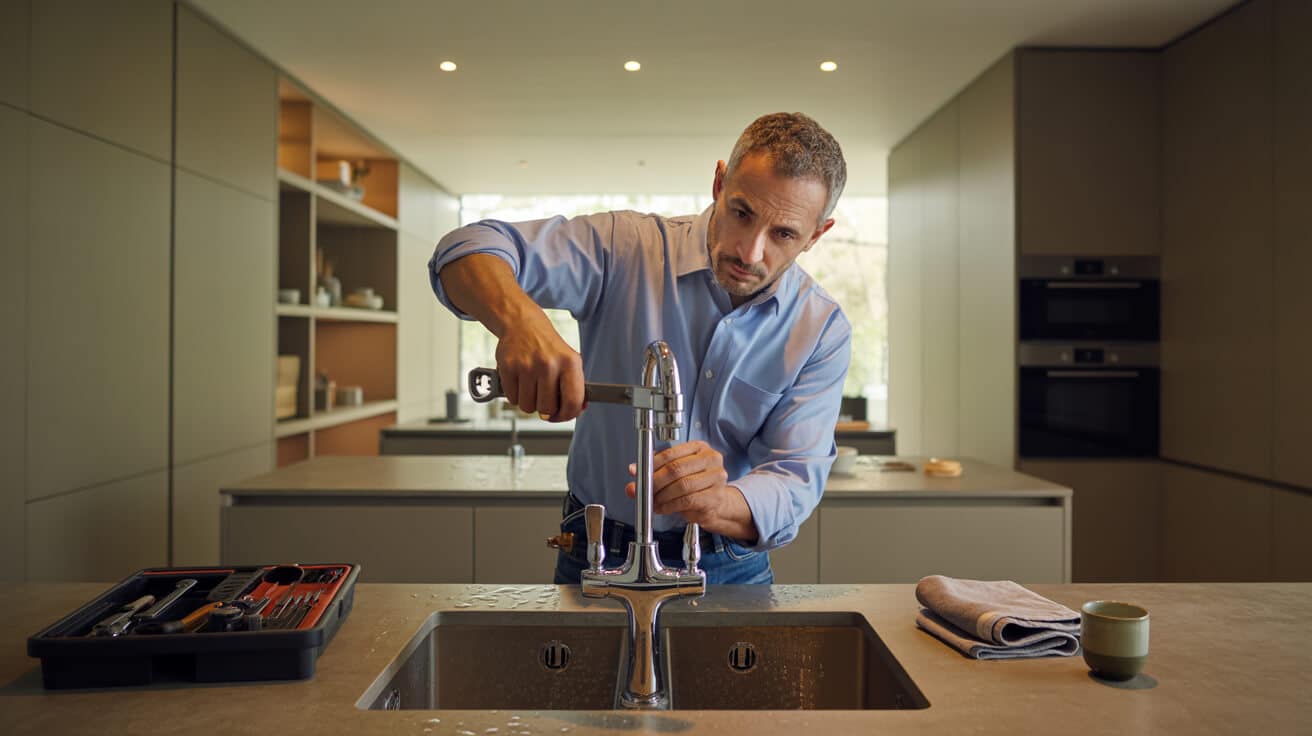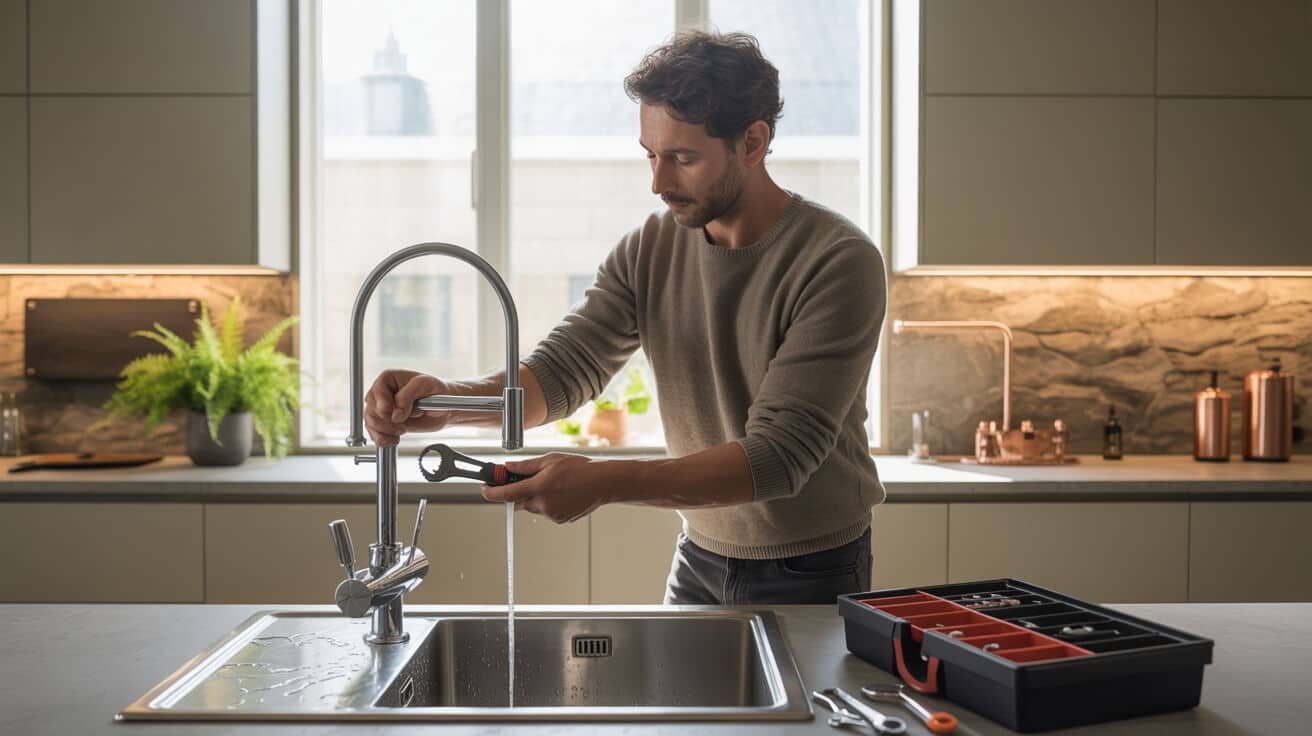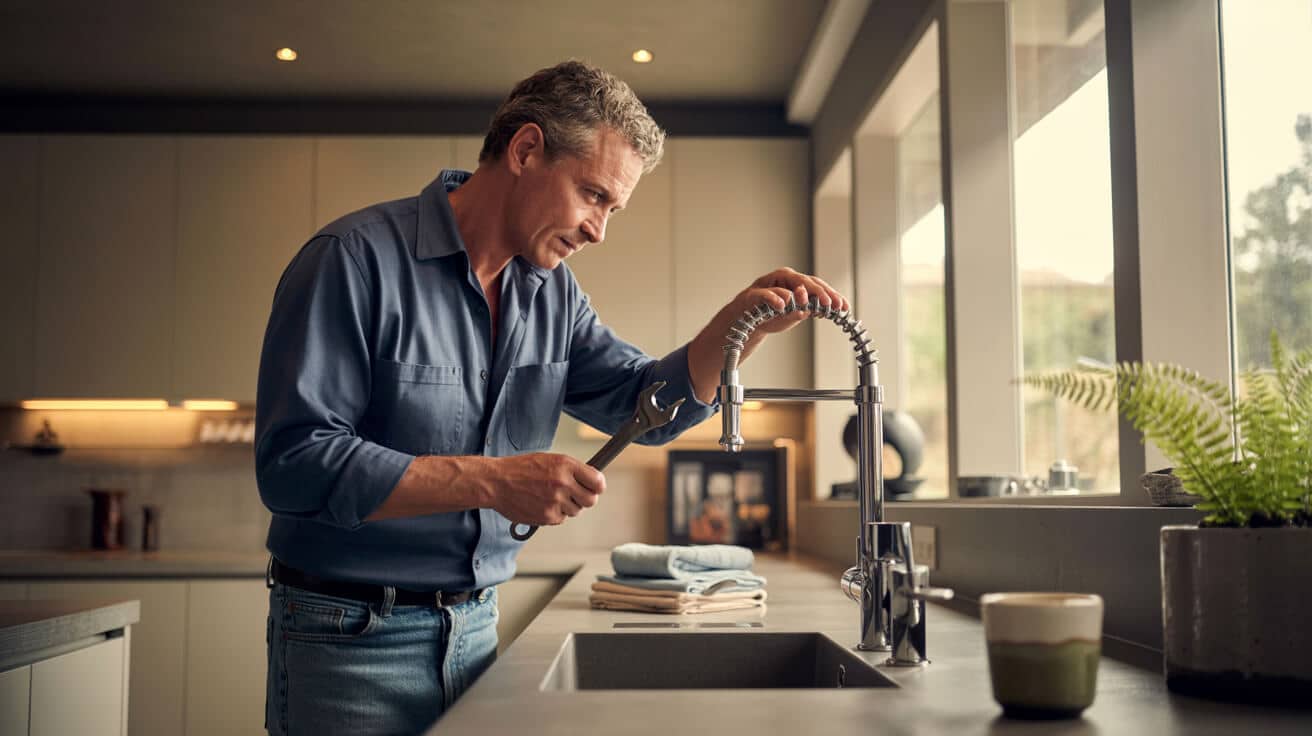Repairing a mixer tap entails the systematic restoration of water flow, temperature regulation, and leak prevention, all while safeguarding surrounding materials, fixtures, and property assets. The most frequent faults—such as drips, seeping at the base, or erratic flow—originate from component wear, scaling, or faulty installation, and can precipitate further plumbing system imbalance if not promptly addressed. Resolution of these issues preserves the internal equilibrium of your water system, directly influencing home comfort, tenant satisfaction, occupancy costs, and asset protection, with robust service standards exemplified by providers like Plumbers 4U.
Etymology or name origin
The phrase “mixer tap” stems from the unit’s core capability to blend hot and cold water streams in a single device. While “tap” is standard in British and Commonwealth contexts, “faucet” dominates North American English, reflecting historical evolutions in plumbing terminology. Subtypes such as “monobloc” or “dual-lever” reference mounting/or actuation style, encoded in patent languages since the late 1800s and reinforced by sectoral standards, building codes, and advertising, marking the shift from parallel single-taps to an integrated, unified fixture.
Overview / context
Mixer taps have transitioned from rare luxury to default standard in residential, commercial, and public buildings, predominantly due to their functional efficiency, design adaptability, and health-safety benefits. Their integration into water distribution systems enables precise temperature control, energy conservation, and improved hand hygiene. For your organisation, a working mixer tap safeguards everyday routines, minimises water waste, optimises energy consumption, and sustains regulatory compliance under evolving property and public health legislation.
Routine mixer tap repair is also a strategic measure for facility managers aiming to extend lifecycle value, minimise unplanned downtime, and comply with legal mandates on rental property maintenance, Legionella risk, and water-use reporting.
History
Origins of water blending
The first inventions approximating modern mixer taps emerged in the late nineteenth century, supporting simultaneous hot and cold supply to sinks and basins as piped water became mainstream in urban homes. Early designs prioritised mechanical simplicity and survived by referencing existing valve and washer technologies used in single taps.
Momentum through industrialization
By the early to mid-twentieth century, the manufacture of mixer taps shifted from bespoke brassware to mass-produced, patent-protected devices. Growth in central heating and domestic hot water systems created demand for temperature-regulated outlets, first in upmarket hotels and public facilities, then eventually in standard housing stock. Advances in cartridge engineering, finish standards (chrome, anodized), and pressure-balancing further normalised mixer tap adoption.
Contemporary innovation
Recent decades have seen mixer taps equipped with ceramic disc, pressure-compensating, and thermostatic mechanisms that extend service intervals, reduce scaling, and improve energy efficiency. Legislative shifts—such as the Water Supply (Water Fittings) Regulations 1999 (UK), and performance codes in Europe, North America, and Australasia—have pushed both manufacturers and service firms to prioritise repairability, reduced lead content, eco-certification, and child safety.

Concept / description
Mechanism and structure
A mixer tap’s functionality arises from its internal blending mechanism, translating user input at handles or levers into controlled proportional mixing of your property’s hot and cold inlets. Modern variants may use compression valves (with washers), ceramic discs (for smooth, low-force motion), or thermostatic cartridges (for temperature precision and anti-scald). The main body—cast from brass, stainless steel, or engineered plastics—anchors both the spout and the control actuators, routed internally to the blending chamber.
Component anatomy
- Handles/actuators: Levers, knobs, or sensors that translate user movement into valve/capsule rotation.
- Cartridge/disc/washer: The core mixing unit; different types determine repair complexity and spare part availability.
- Spout: Directs and shapes water outflow, often with replaceable aerators to optimise flow, pressure, and reduce splash.
- Seals and O-rings: Prevent internal leaks; frequent failure points.
- Check valves and backflow devices: In multi-outlet or commercial systems, guard against cross-contamination.
- Fixing kits/tails: Allow mounting through deck, countertop, or wall, ensuring stability and pressure compatibility.
Functionality / purpose / applications
Mixer taps serve your everyday hygiene, cleaning, and utility needs, introducing water at safe, user-selected temperatures. The device’s inbuilt mechanisms protect against scalds, enable compliance with anti-Legionella regimes, and satisfy regulations for water outlet temperature, particularly for vulnerable populations. Plumbers 4U and comparable firms routinely instal and maintain these taps across:
- Domestic kitchens: Supporting safe washing, food preparation, and energy reduction via instant temperature moderation.
- Bathroom basins and showers: Providing single-action temperature blending, enhancing accessibility for users with reduced dexterity.
- Commercial and public facilities: Enabling compliance with public health (e.g., HSE, NHS) and accessibility laws.
- Specialised applications: Hospitals, care homes, and educational settings, where regulated water delivery is legally mandated.
Consistently functional mixer taps limit bacterial growth risks, deliver performance transparency for your company, and augment property value.
Classifications / types / variants
Mixer taps are categorised by their handling, installation, and internal mechanisms. The principal distinctions include:
| Name | Description | Common Contexts |
|---|---|---|
| Monobloc | One-piece, single-hole fitting. Single or twin lever controls. | Kitchen, basin |
| Dual-lever | Two handles (hot/cold), internally blended. | Traditional basins |
| Thermostatic | Manual/auto blending; temperature preset and anti-scald. | Showers, hospitals |
| Sensor/touchless | Hands-free operation via infrared/capacitive sensors. | Public restrooms |
| Deck-mounted | Fixes through sink/basin hole (usually monobloc) | Kitchens, utility |
| Wall-mounted | Plumbed through wall, floating tap. | Baths, luxury units |
| Pillar tap | Separate hot and cold, can be converted with blending bridge. | Older UK bathrooms |
Critical to repair methodology is understanding the cartridge/valve model, access method, and brand-specific quirks.
Systems / tools / methodologies
Efficient repair of a mixer tap blends technical proficiency, specialised equipment, and contextual understanding of legal and safety frameworks. Professionals—such as those at Plumbers 4U—apply both common and advanced methods, ensuring compliance, durability, and structured documentation for your company or property.
Hand and specialty tools
- Adjustable spanners, hex/Allen keys, slot/Phillips screwdrivers, slip-joint pliers: Core for component removal and installation.
- Basin wrench: Essential for accessing tight, inaccessible retaining nuts beneath sinks.
- Cartridge pullers, seat dressing kits: Remove stubborn or proprietary mechanisms, resurface seats for washer-based taps.
- Descaling systems, chemical soaks: Address mineral buildup common in hard water areas.
Consumables
- PTFE tape: Seals new or disturbed threaded connections.
- OEM-compatible cartridges, O-rings, seals: Sourced to match tap model and pressure regime.
- Lubricants, cleaning pads: Maintains handle smoothness, prevents future seizure or scaling.
Repair sequence
- Isolate relevant water supplies using local or main shutoff (stopcock or isolation valves).
- Dismantle decorative caps or covers; unscrew or unclip handles according to product manual.
- Remove cartridge, washer, or disc with minimal force, documenting component orientation for correct reinstallation.
- Inspect for scale, corrosion, or perishing. Clean or replace as necessary.
- Replace all seals, ensuring compatibility with potable water standards, reinstall with correct alignment.
- Reassemble tap, restore water supply, and test under pressure for leaks and actuation smoothness.
- Complete job log with part numbers and photographic documentation for compliance and record-keeping.
Brand variations in fixings, tools, or component sizing mean the above steps must always be cross-checked against manufacturer documentation to avoid invalidating warranty entitlement or introducing compliance risk.

Stakeholders / entities involved
Understanding who is affected by mixer tap performance and repair clarifies the emotional, legal, and financial stakes for all parties involved:
Homeowners
- Value smooth operation, quietness, and resilience; seek to minimise emergency repairs and future costs.
- May attempt basic diagnosis or straightforward O-ring swap, often seeking professional support for cartridge or valve replacement.
Landlords and property managers
- Responsible for legal compliance (e.g., safety certificates, anti-scald, HMO guidelines), tenant comfort, insurance requirements, and asset upkeep.
- Stand to minimise claims, tenant churn, and reputational impact via scheduled maintenance and prompt, certified repairs.
- Document repairs for compliance and audit.
Tenants
- Entitled to timely repair of leaks, loss of function, or temperature instability for safety and quality of life.
- Obliged to promptly report issues, ensure repair access, and adhere to property use standards.
Facilities managers and agents
- Administer large-scale systems for offices, blocks, public buildings—seeking minimal downtime, streamlined supplier relationships, and seamless documentation.
- Prioritise forward planning for spares, emergency protocol, and supplier vetting.
Plumbing professionals
- Deliver core service, warranty documentation, and compliance logs on behalf of owners/managers.
- Keep detailed records of repairs, instal parts from certified/approved sources, and carry adequate insurance.
Providers such as Plumbers 4U emphasise transparent communication among stakeholders to reduce disputes, increase satisfaction, and ensure legal defensibility.
Legal / regulatory / ethical considerations
Statutory codes
- WRAS (Water Regulations Advisory Scheme): Certifies taps for material safety, pressure performance, and non-contamination.
- Water Supply (Water Fittings) Regulations 1999: Mandates proper installation, maintenance, and repair across England and Wales.
- Building Regulations Part G: Requires anti-scald devices, temperature limitations; especially relevant for HMOs, hospitals, schools, and new builds.
- Local Authority guidelines: Supplement national standards, focusing on landlord responsibility, HMO management, and routine inspection documentation.
Duties and risks
- Landlords and property managers must verify each repair meets all regulatory and insurance criteria, or face penalty, licencing risk, or insurance claim rejection.
- Registered, insured professionals must perform repairs; improper repairs by unqualified persons risk invalidating manufacturer warranties, causing legal exposure, or introducing contamination/legionella risk.
Ethical practice
- Providers are encouraged to offer clear quotations, itemise parts/labour, recycle removed fixtures, and respect privacy.
- Proactive advice—such as maintenance tips or recommendations for water softening in hard water areas—can enhance user trust and property value, limiting future emergency interventions.
Performance metrics / data / measurements
Mixer tap performance is assessed through quantifiable data points and qualitative operational indicators.
| Parameter | Typical Range/Indicator | Impact |
|---|---|---|
| Flow rate | 4–10 litres/minute (domestic), >10 L/min (commercial) | Water efficiency, comfort, hygiene |
| Pressure rating | Min 0.1 bar–max 5 bar (check manufacturer) | Component stress, leak risk |
| Temperature limit | 48–55°C (thermostatic outlets) | Scald protection, compliance |
| Component lifespan | 5–15 years (cartridge/valve), 2–5 years (O-rings/seals) | Maintenance schedule |
| Failure rates | Higher in hard water areas, with substandard components, or after poor installation | Emergency callout, cost |
Performance tracking, integral to your property’s asset management, enables timely interventions, minimises water/energy losses, and supports warranty/insurance claims.
Challenges / barriers / limitations
Technical
- Non-standard, obsolete, or proprietary cartridges, handles, or fixings complicate parts sourcing and repair, particularly for imported or discontinued brands.
- Accumulation of scale and corrosion, especially in hard water regions, accelerates wear or renders parts immovable without risk of collateral damage.
Economic
- Repairs below a certain value threshold (low-cost, high-age taps) may be financially unviable; replacement becomes the recommended path.
- Hidden or systemic faults (e.g., water pressure inconsistency or pipework faults) mean mixer tap issues are sometimes symptomatic rather than isolated.
Social
- In multi-tenant or high-use buildings, conflicting responsibilities for reporting, maintenance, and billing can delay action or escalate disputes.
- Scheduling repairs in busy commercial settings may be challenging, risking unplanned disruption and revenue loss.
Operational
- Accessibility limitations—under-mount sinks, narrow cabinets, tiled-in fixings—hinder standard repair techniques, necessitating specialist tools and potentially more invasive work.
- Emergency shutoffs can disrupt entire properties, requiring careful stakeholder communication and swift remedial action.
Impact / influence / legacy
Successful mixer tap repair contributes directly to reduced water and energy consumption in your home or building, prevents secondary water damage (such as warping, mould, or subfloor rot), and contributes to a pleasant acoustic and operational environment. Indirect influences include elevated tenant or customer satisfaction, elevated property value, and consistent regulatory compliance—both for individual landlords and facility-level managers. Mixer tap innovation and service quality, as championed by providers like Plumbers 4U, have helped drive sector-wide gains in service reliability and occupant well-being.
Future directions, cultural relevance, and design discourse
Emerging mixer tap trends include the evolution of ultra-long-life cartridges, new surface coatings to minimise scaling, and legally required eco-performance labelling. Social expectations are shifting toward designs that accommodate user disabilities and new hygiene realities post-pandemic. Modular, tool-less repair concepts are being integrated by leading brands, promoting both sustainability and operational simplicity. As your organisation or property seeks to balance aesthetic, regulatory, and operational needs, innovations in mixer tap engineering will continue to influence comfort, compliance, and cost outcomes for years to come.

